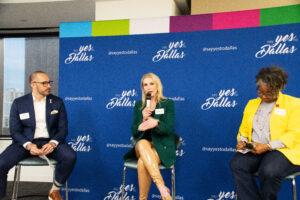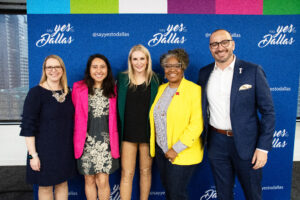By Nicole Ward, Data Journalist
According to the Bureau of Labor Statistics, there are more than 10 million open jobs in the United States, and companies’ ability to attract talent requires consistent evaluation as priorities and the talent pool evolve.
To help Dallas Region companies navigate the talent attraction landscape, the Dallas Regional Chamber (DRC) hosted a Talent Attraction Talk, presented by BGSF, Tuesday, March 28, focused on how to get talent in the door and give them a compelling reason to stay. This event series is part of the DRC’s Say Yes to Dallas initiative.

Kelly Ann Doherty, Executive Vice President and Chief Administrative Officer at Mr. Cooper Group, and Halima K. McWilliams, Associate Principal for Human Resources Operations and Culture at Corgan, joined moderator Mike Pierce, Vice President of Lockton Dunning Benefits, to share insights and recruiting hacks.
Doherty and McWilliams agree that company culture is important and should be evaluated constantly, even if it is not always the deciding factor for recruits. Doherty indicated the value of acknowledging that culture is not static but constantly evolving, and that, importantly, it is not a top-down exercise.
“Leaders can sit around the table and say, ‘this is what we want,’” Doherty said. “But if it’s not what employees are experiencing, it won’t stick.”
According to the panelists, company culture can encompass style of dress; in-office or remote work, or a mix of the two; and incorporating diversity, equity, and inclusion (DEI).
“DEI is not just an employee engagement tool, it’s a good business practice,” McWilliams said. “And diversity doesn’t just mean skin color or gender but also things that are not identifiable just by looking at someone.
“If you’re not bringing [DEI] up, you’re losing. Period,” McWilliams added.
McWilliams shared that investing time to understand the company culture and communicate it to candidates can help attract candidates that meet organizational needs and fit into the existing team. To understand company culture, Doherty recommends repeating a cycle of asking employees their thoughts, analyzing the feedback, enacting change, then telling employees what has been modified and the outcomes leadership hopes to see.
“So many companies spend time on the customer journey,” Doherty said. “If you think about your employee journey—from the moment they hear about your organization to the moment they leave—you will identify both pain points and areas you’re doing really well. When you think of it in terms of that total journey, you’re going to find a lot of opportunities to make it better.”
When it comes to the early days of an employee’s engagement with a company, McWilliams said, “clarity is respect” and that hiring managers should be transparent about roles, responsibilities, and any impending organizational change.
Doherty said companies in the Dallas Region can and should draw on the economic strength of the region as an advantage in recruiting.
 “All the economic development we’ve seen in the region has convinced a lot of people to consider Dallas long-term,” Doherty said.
“All the economic development we’ve seen in the region has convinced a lot of people to consider Dallas long-term,” Doherty said.
The consensus from the discussion was that recruiting styles change over time, but the everlasting common thread is data. Companies cannot know if their talent attraction process needs to change without knowing its strengths and opportunities; monthly internal pulses, exit surveys, and candidate surveys are essential in this journey.
This Talent Attraction Talk was presented by BGSF. Carrington Coleman was a partner sponsor, and OCC was the Say Yes to Dallas Featured Employer.
Want to learn more about how your company can attract top talent? Visit the DRC’s Talent Attraction webpage for toolkits and resources.